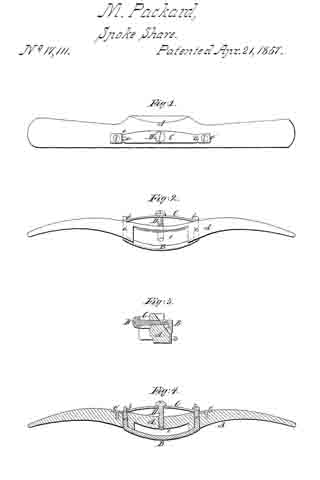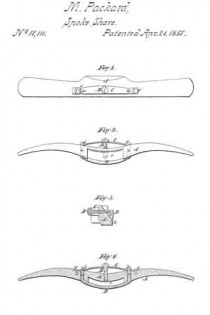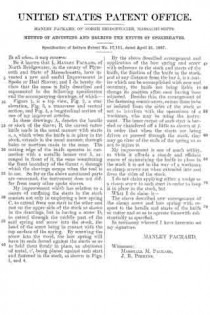No. 17,111 – Adjusting And Holding The Knives Of Spokeshaves (Manley Packard) (1857)

UNITED STATES PATENT OFFICE.
_________________
MANLEY PACKARD, OF NORTH BRIDGEWATER, MASSACHUSETTS.
METHOD OF ADJUSTING AND HOLDING THE KNIVES OF SPOKESHAVES.
_________________
Specification of Letters Patent No. 17,111, dated April 21, 1857.
_________________
To all whom it may concern:
Be it known that I, MANLEY PACKARD, of North Bridgewater, in the county of Plymouth and State of Massachusetts, have invented a new and useful Iniproveinent in Spoke or Heel Shaves; and I do hereby declare that the same is fully described and represented in the following specification and the accompanying drawings, of which —
Figure 1, is a top view, Fig. 2, a rear elevation, Fig. 3, a transverse and central section, and Fig. 4, a longitudinal section of one of my improved articles.
In these drawings A, denotes the handle or stock of the shave; B, the curved cutter knife made in the usual manner with starts a, a, which when the knife is in place in the stock, extends in the usual manner, through holes or mortises made in the same. The cutting edge of the knife operates in connection with a metallic bearer rest b, arranged in front of it, the same constituting the front boundary of the throat c, through which the shavings escape when the tool is in use. So far as the above mentioned parts are concerned, the instrument does not differ from many other spoke shaves.
My improvement which has relation to a means of confining the starts in the stock consists not only in employing a bow spring C, to extend from one start to the other and rest on the upper side of the stock as shown in the drawings, but in having a screw D, to extend through the middle part of the said spring and screw into the stock, the head of the screw being in contact with the top surface of the spring. By screwing the screw into the wood, the bow spring will have its ends forced against the starts so as to hold them firmly in place, an abutment of metal, c’, being placed against each start and fastened in the stock, as shown in Figs. 1, and 4.
By the above described arrangenient and application of the bow spring and screw with reference to the stock and starts of the knife, the fixation of the knife in the stock, and at any distance from the bar b, is a matter which can be accomplished with ease and certainty, the knife not being liable to change its position after once having been adjusted. Besides this, the arrangement of the fastening contrivances, causes them to be so isolated from the sides of the stock as not to interfere with the operations of a workman, who may be using the instrument. The inner corner of each start is beveled or charnfered olf a little as shown at f, in order that when the starts are being driven or pressed through the stock, they may go clear of the ends of the spring so as not to injure it.
My improveinent is one of much utility, as while it affords a simple and efficient means of maintaining the knife in place in the stock it is not in the way of a workman as clamp screws are when extended into and from the sides of the stock.
I do not claim applying either a wedge or a clamp screw to each start in order to keep it in place in the stock, but
What I do claim is —
The above described new arrangement of the clamp screw and bow spring with respect to the handle and starts of the knife or cutter and so as to operate therewith substantially as specified.
In testimony whereof I have hereunto set my signature.
MANLEY PACKARD.
Witnesses :
MARSHALL M. PACKARD,
J. R. PERKINS.


